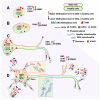NSC Physiological Features in Spinal Muscular Atrophy: SMN Deficiency Effects on Neurogenesis
- PMID: 36499528
- PMCID: PMC9736802
- DOI: 10.3390/ijms232315209
NSC Physiological Features in Spinal Muscular Atrophy: SMN Deficiency Effects on Neurogenesis
Abstract
While the U.S. Food and Drug Administration and the European Medicines Evaluation Agency have recently approved new drugs to treat spinal muscular atrophy 1 (SMA1) in young patients, they are mostly ineffective in older patients since many motor neurons have already been lost. Therefore, understanding nervous system (NS) physiology in SMA patients is essential. Consequently, studying neural stem cells (NSCs) from SMA patients is of significant interest in searching for new treatment targets that will enable researchers to identify new pharmacological approaches. However, studying NSCs in these patients is challenging since their isolation damages the NS, making it impossible with living patients. Nevertheless, it is possible to study NSCs from animal models or create them by differentiating induced pluripotent stem cells obtained from SMA patient peripheral tissues. On the other hand, therapeutic interventions such as NSCs transplantation could ameliorate SMA condition. This review summarizes current knowledge on the physiological properties of NSCs from animals and human cellular models with an SMA background converging on the molecular and neuronal circuit formation alterations of SMA fetuses and is not focused on the treatment of SMA. By understanding how SMA alters NSC physiology, we can identify new and promising interventions that could help support affected patients.
Keywords: differentiation; epigenetic; induced pluripotent stem cells; mitochondria; spinal muscular atrophy; survival motor neuron.
Conflict of interest statement
The authors declare no conflict of interest.
Figures


Similar articles
-
Established Stem Cell Model of Spinal Muscular Atrophy Is Applicable in the Evaluation of the Efficacy of Thyrotropin-Releasing Hormone Analog.Stem Cells Transl Med. 2016 Feb;5(2):152-63. doi: 10.5966/sctm.2015-0059. Epub 2015 Dec 18. Stem Cells Transl Med. 2016. PMID: 26683872 Free PMC article.
-
A Perturbed MicroRNA Expression Pattern Characterizes Embryonic Neural Stem Cells Derived from a Severe Mouse Model of Spinal Muscular Atrophy (SMA).Int J Mol Sci. 2015 Aug 6;16(8):18312-27. doi: 10.3390/ijms160818312. Int J Mol Sci. 2015. PMID: 26258776 Free PMC article.
-
Abnormal mitochondrial transport and morphology as early pathological changes in human models of spinal muscular atrophy.Dis Model Mech. 2016 Jan;9(1):39-49. doi: 10.1242/dmm.021766. Epub 2015 Nov 19. Dis Model Mech. 2016. PMID: 26586529 Free PMC article.
-
Advances in modeling and treating spinal muscular atrophy.Curr Opin Neurol. 2016 Oct;29(5):549-56. doi: 10.1097/WCO.0000000000000368. Curr Opin Neurol. 2016. PMID: 27472505 Free PMC article. Review.
-
Spinal Muscular Atrophy Modeling and Treatment Advances by Induced Pluripotent Stem Cells Studies.Stem Cell Rev Rep. 2019 Dec;15(6):795-813. doi: 10.1007/s12015-019-09910-6. Stem Cell Rev Rep. 2019. PMID: 31863335 Review.
Cited by
-
Ubiquitination Insight from Spinal Muscular Atrophy-From Pathogenesis to Therapy: A Muscle Perspective.Int J Mol Sci. 2024 Aug 13;25(16):8800. doi: 10.3390/ijms25168800. Int J Mol Sci. 2024. PMID: 39201486 Free PMC article. Review.
-
The Designer Drug αPHP Affected Cell Proliferation and Triggered Deathly Mechanisms in Murine Neural Stem/Progenitor Cells.Biology (Basel). 2023 Sep 11;12(9):1225. doi: 10.3390/biology12091225. Biology (Basel). 2023. PMID: 37759624 Free PMC article.
-
Stem cell therapy: A promising therapeutic approach for skeletal muscle atrophy.World J Stem Cells. 2025 Feb 26;17(2):98693. doi: 10.4252/wjsc.v17.i2.98693. World J Stem Cells. 2025. PMID: 40061264 Free PMC article. Review.
-
Emerging Gene Therapy Approaches in the Management of Spinal Muscular Atrophy (SMA): An Overview of Clinical Trials and Patent Landscape.Int J Mol Sci. 2023 Sep 6;24(18):13743. doi: 10.3390/ijms241813743. Int J Mol Sci. 2023. PMID: 37762045 Free PMC article. Review.
-
Physiological Features of the Neural Stem Cells Obtained from an Animal Model of Spinal Muscular Atrophy and Their Response to Antioxidant Curcumin.Int J Mol Sci. 2024 Jul 31;25(15):8364. doi: 10.3390/ijms25158364. Int J Mol Sci. 2024. PMID: 39125934 Free PMC article.
References
Publication types
MeSH terms
Substances
LinkOut - more resources
Full Text Sources
Medical
Miscellaneous

